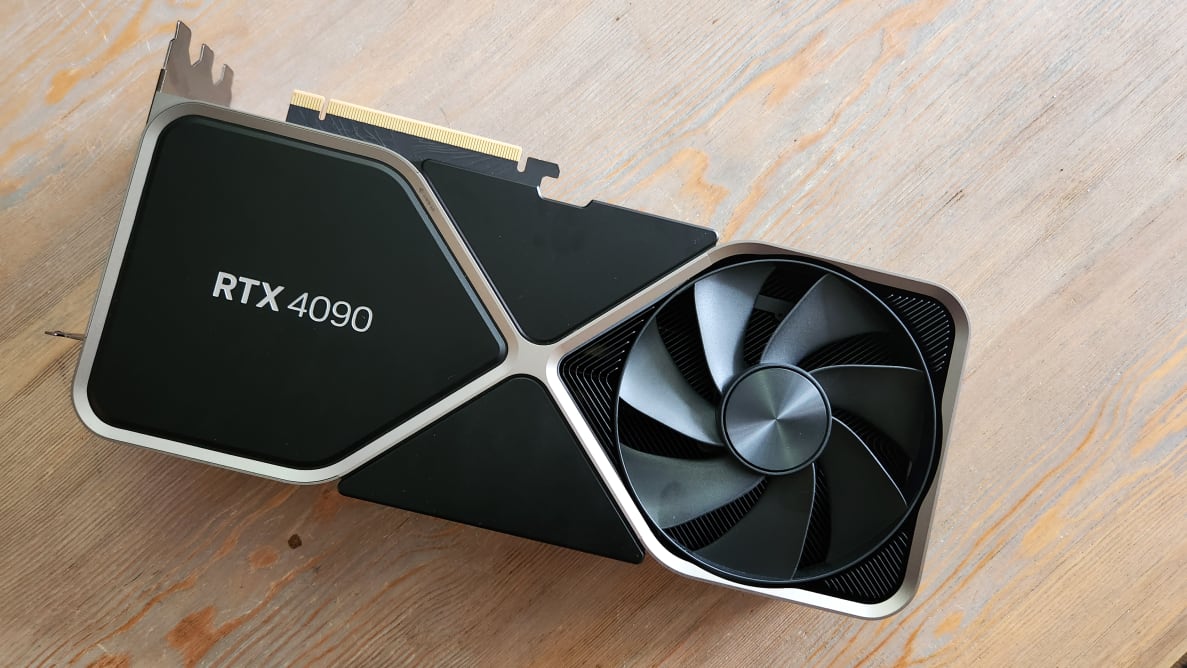Pros
-
Blazing speeds
-
Incredible upscaling performance
Cons
-
Issues with current-gen hardware
-
Not many DLSS 3-supported games
-
Power-hungry
About the Nvidia GeForce RTX 4090
Here are the specs of the graphics card we tested:
- Price: $1,600
- CUDA Cores: 16384
- Tensor Cores: 512
- Base clock: 2.52 GHz
- Boost clock: 2.23 GHz
- Memory: 24 GB GDDR6X
- Memory interface width: 384-bit
- Display support: 7680 x 4320, up to four monitors
- Ports: 1x HDMI, 3x DisplayPort
- Power draw: 450 W
The RTX 4090 starts at $1,599. Nvidia's other two upper-tier 40-series cards, the RTX 4080 and RTX 4070 Ti cost $1,200 and $800, respectively. We tested the Founder’s Edition model manufactured by Nvidia, though a variety of partner models from Asus, Gigabyte, Colorful, MSI, PNY, Zotac, and others exist.
What we like
The performance is mind-blowing

More power means a bigger card.
The RTX 4090 drives such high frame rates that it would be a waste to have anything other than a 4K monitor, especially one with a refresh rate under 144Hz. In our testing, the RTX 4090 consistently reached 100+ fps at 4K and the highest graphics preset (DLSS and ray tracing off) in most of the games we tested.
Some notable results: Far Cry 6 130 fps, Total War: Warhammer 3 100 fps, Borderlands 3 126 fps, Assassin’s Creed Valhalla 110 fps, and Hitman 3 178 fps. Cyberpunk 2077 was the only one that didn’t break 100, coming in at 78 fps—but that’s still nearly twice the speed compared to the RTX 3080, which only managed 40 fps with the same testing configuration.
The 4090 also gets 114 fps in Cyberpunk 2077 at 1080p with ray tracing cranked to the max, but DLSS off; the game is not playable at the same resolution and graphics settings with an RTX 3080, and the RTX 3090 barely misses the 60-fps cutoff.
Nvidia’s latest flagship card is also a major winner for anyone who does creative work like 3D rendering and 4K or even 8K video editing. The 4090 can render twice as many frames per second as the 3090, and it does so in about half the time compared to Nvidia’s last-gen graphics cards.
DLSS 3 is pure magic
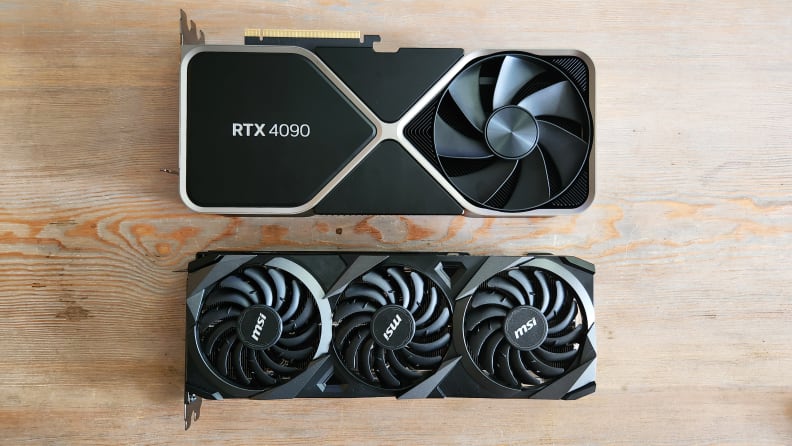
Top: RTX 4090. Bottom: MSI triple fan RTX 3080 Ti
The changes Nvidia made to its DLSS frame rate-boosting tech are remarkable, not only because of how much it can increase frame rates but also how indistinguishable it is from frames not rendered with DLSS.
Cyberpunk 2077 is a perfect example of a graphically demanding game that takes advantage. With the resolution set to 4K, the ray tracing graphics preset on ultra, and DLSS set to performance, the RTX 4090 averaged 130-140 fps. Without DLSS 3, the GPU averaged 40 fps—so that’s a 90-100 fps jump! (DLSS 2 can only do about half of that or less.)
This also means any other 40-series GPUs Nvidia releases this year or next year will benefit greatly from this massive frame rate bump, so I fully expect to see mid-range cards pushing high-end framerates thanks to DLSS 3.
Aside from a few hiccups (which I talk about below), the game ran super smoothly and I could not distinguish the upscaled frames from the natively rendered frames. Everything looked gorgeous.
Unfortunately, it will be a while before DLSS 3 is as widely adopted as DLSS 2. Currently, less than two dozen games have DLSS 3 support though more are on the way (Cyberpunk 2077 received the update at the start of 2023). So, if you were planning on buying the RTX 4090 today and hopping straight into amazing, ray traced frame rates, you’ll find your options very limited.
What we don’t like
It doesn’t play nice with some current-gen hardware
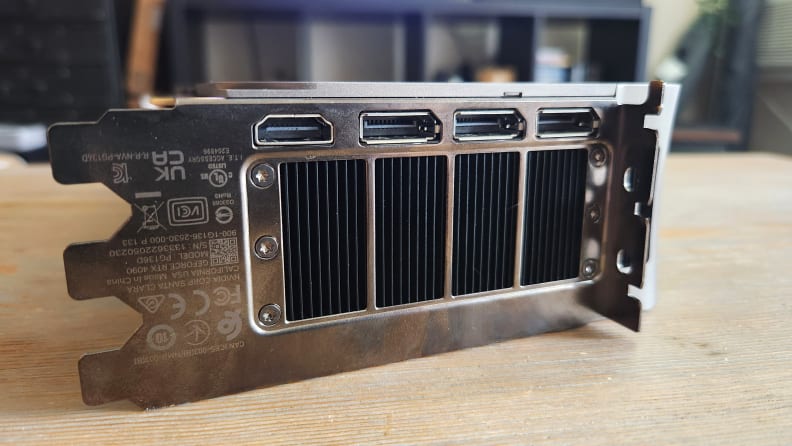
The RTX 4090 supports three DisplayPort connections and one HDMI connection.
If you are wondering why we didn’t test the RTX 4090 with a brand-new Ryzen 9 7950X, it’s because we couldn’t get the graphics card to work with it. Even after installing the driver provided by Nvidia and flashing the Gigabyte motherboard with a new BIOS version that was supposed to fix issues other reviewers were having, our problems persisted. (At least the 4090 performs great with the Ryzen 7 5800X3D.)
Our test bench loaded into Windows 11 without issue, but the 4090 did not output video to our monitor. We tried uninstalling and reinstalling the driver. We tried putting the graphics card into every PCIe slot. We tried using an HDMI cable instead of DisplayPort. Nothing worked. But we had zero issues testing the Ryzen 7000-series chips with last-gen graphics cards, both Nvidia and AMD.
We were able to get the 4090 working once with our current-gen AMD test system, but it was more of an “It randomly started working” than a “We did this specific thing to fix it.” When that happened, however, we couldn’t get any of the popular frame rate monitoring tools to show up as an overlay or record frame rates. FrameView didn’t work. The GeForce Experience didn’t work. Fraps didn’t work. MSI Afterburner didn’t work.
But after moving the 4090 to a test bench configured with a Ryzen 5000-series chip and X570 motherboard, we got the display to show the Windows 11 desktop, and all those frame rate monitoring tools worked.
It’s hard to recommend anyone—even if you have the money—purchase an incredibly expensive piece of PC hardware when our own experience with it was rife with issues.
Some DLSS 3 issues
When it first announced the RTX 4090, Nvidia used Cyberpunk 2077 to show off the incredible performance of DLSS 3. But while DLSS 3 is impressive, we ran into some issues, most notably during cutscenes.
In the middle of the River Ward and Judy Alverez romance scenes, performance dropped from 130-140 fps to as low as 40 fps. This caused major visual stuttering, artifacts, and issues with the sound. It corrected itself as the game progressed to the end of the scenes, but the fps drop was so sudden and so bad it felt like the game was going to crash. (Thankfully it didn’t.) It happened consistently with the River Ward scene but only happened occasionally with the Judy Alverez scene.
DLSS 3 worked beautifully at every other point I tried in the game, but I’ve never seen DLSS 2 choke like that in the same game.
It needs as many cables as Medusa has snakes in her hair

Top: The RTX 4090. Bottom: The RTX 3080.
When the RTX 30-series cards came out, I was not impressed with Nvidia’s pin adapter for its Founders Edition cards, especially on the RTX 3090; the two short cables awkwardly jutted out, which made it harder to neatly tuck them away inside a case. The RTX 4090, however, is a glutton for power, so the adapter itself has four cables instead of two. And the cables are longer.
The longer cables help a bit with pulling everything out of the way, but there are just so many more cables to manage now. What’s more, the 4090’s pin connection is on the top of the card, but when you install the GPU in your case, that port will be on the side, facing the side of your case. That means you’ll need to pull all those cables up and over the top of the card to tuck them away. The RTX 4090 makes cable management harder.
But it needs all those cables, and at least a 1000W power supply to feed its bottomless stomach and leave you with enough headroom. There’s no getting around this.
Should you buy the Nvidia GeForce RTX 4090?
No, it’s impressive but impractical for the majority of gamers
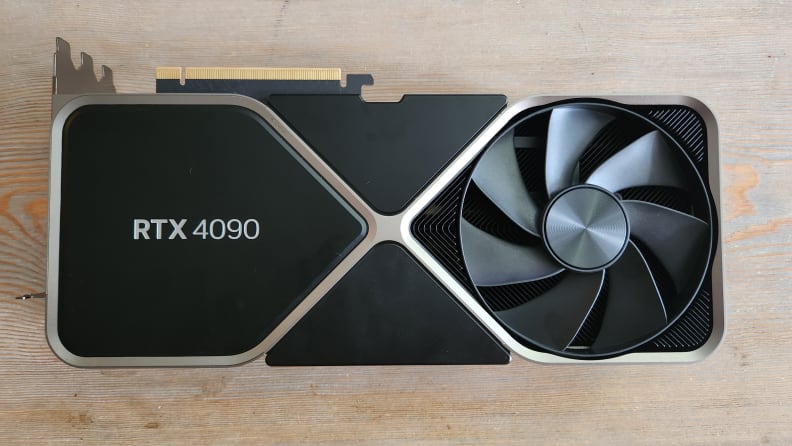
The RTX 4090 Founders Edition, or as I call it, The Beast.
The RTX 4090 was made for three types of people: professional creatives who need the amount of performance only the 4090 is equipped to handle; professional esports players with a GPU that can drive high refresh rate monitors; and people who have enough expendable income to drop $1,600 on a graphics card like it’s a penny in a fountain.
For the rest of us average gamers, it's impractical and even wildly outside our budgets to upgrade to the RTX 4090 when DLSS 3 is only available on a handful of games and isn’t backward compatible with 30-series cards. If you’re obsessed with driving 4K content, especially with ray tracing, this is the graphics card that will make that happen with dozens of extra frames left over, but there aren’t enough DLSS 3 compatible games right now to justify the cost.
Additionally, I was unable to get the 4090 working with the same current-gen configuration I used to review AMD’s new 7000-series processors, so its possible other people could encounter the same issues. (At of the time of this writing, Nvidia and I have not been able to figure out the cause.)
The RTX 4090 is impressive, but most people will be better off getting an RTX 4080 or a high-end, 30-series graphics card. The $1,200 RTX 4080 and $800 RTX 4070 Ti will both comfortably outperform a last-gen RTX 3090 Ti. If you want to check out the very peak of AMD’s offerings, the sub-$1,000 Radeon RX 7900 XTX will trade blows with a 4080, but nothing else can touch the 4090’s performance.
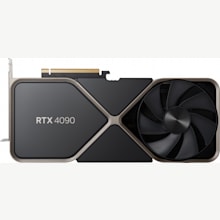
Although it's expensive, the RTX 4090 is the most powerful GPU you can buy.
Buy now at Best BuyMeet the tester
Joanna specializes in anything and everything gaming-related and loves nerding out over graphics cards, processors, and chip architecture. Previously she was a staff writer for Gizmodo, PC Gamer, and Maximum PC.
Checking our work.
Our team is here for one purpose: to help you buy the best stuff and love what you own. Our writers, editors, and lab technicians obsess over the products we cover to make sure you're confident and satisfied. Have a different opinion about something we recommend? Email us and we'll compare notes.
Shoot us an email